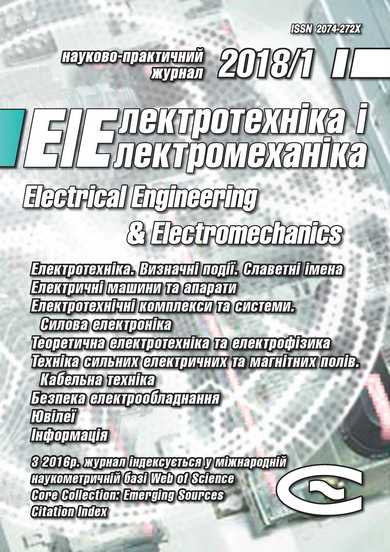POWERFUL GENERATORS OF HIGH-VOLTAGE PULSES WITH NANOSECOND FRONTS
DOI:
https://doi.org/10.20998/2074-272X.2018.1.09Keywords:
spark gap discharger, generator, switch, transistor, SOS-diode, high-voltage pulse transformer, pulse repetition frequency, capacitive storage, inductance, load resistanceAbstract
Purpose. Purpose of the article is to show the possibility of joint efficient operation of semiconductor switches and spark arresters in high-powerful high-voltage generators for obtaining nanosecond and shorter pulse fronts on a high-voltage load. Methodology. The variants of generators of power high-voltage pulses with semiconductor switches in the form of IGBT-transistors, SOS-diodes and spark dischargers as pulse front peaking spark gaps are considered. A scheme is proposed for such a generator of high-voltage pulses with nanosecond front on the basis of a linear pulsed transformer in the Tesla scheme. Results. On the complex load of the generator in the form of a serial connection of a gas bubble in water with a discharge in it and a layer of water under the bubble, voltage pulses with an amplitude of 23 kV and current pulses with an amplitude of 15 A were obtained. In this case, the pulse front, both voltage and current, on the levels 0.1-0.9, was approximately 10 ns, and the repetition rate of pulses in the load ranged from 1200 to 5000 pulses per second. Originality. A scheme is proposed for a generator of high-voltage pulses with a nanosecond front. The difference of the proposed generator with a nanosecond front, high pulse repetition rate, using its high-voltage and low-voltage circuits in the discharge circuit, is the presence in its composition of a linear pulse transformer and a system of peaking of pulse front using SOS diodes and spark gaps. Practical value. These generators considered in this work can find wide application in high-voltage technologies, including decontaminating water treatment, water purification by electric discharges.References
1. Mesiats G.A. Impul'snaia energetika i elektronika [Pulsed power and electronics]. Moscow, Nauka Publ., 2004. 704 p. (Rus).
2. Muhammad H. Rashid. Power electronics handbook: devices, circuits, and applications handbook. Edited by Muhammad H. Rashid. 3rd ed. Butterworth-Heinemann is an imprint of Elsevier 30 Corporate Drive, Suite 400, Burlington, MA 01803, USA; Linacre House, Jordan Hill, Oxford OX2 8DP, UK, 2011. 1390 p.
3. Boyko N.I., Evdoshenko L.S., Zarochentsev A.I., Ivanov V.M., Konyaga S.F. The high-voltage complex with two high frequency generators that regulate modes of corona and barrier discharges when processing gaseous hydrocarbons. Technical Electrodynamics, 2012, no.2, pp. 105-106. (Rus)
4. Boyko N.I., Bortsov A.V., Evdoshenko L.S., Ivanov V.M. Generators of high-voltage pulses with a repetition rate of 50000 pulses per second. Instruments and Experimental Techniques, 2011, vol.54, no.4, pp. 533-541. doi: 10.1134/s0020441211030225.
5. Boyko N.I., Bortsov O.V., Evdoshenko L.S., Іvanov V.M., Ivankina A.I., Tur A.N. Pulsed corona discharge ionization with enlarged zone of ionization: physical fundamentals of obtaining and the perspective fields of application. Electrical Engineering & Electromechanics, 2004, no.3, pp. 98-104. (Rus). doi: 10.20998/2074-272X.2004.3.20.
6. Boyko N.I., Bortsov O.V., Evdoshenko L.S., Zarochentsev O.І., Ivanov V.M. Using pulsed corona discharge with enlarged zone of ionization for the conversion of toxic gaseous waste. Electrical Engineering & Electromechanics, 2007, no.4, pp. 64-65. (Rus). doi: 10.20998/2074-272X.2007.4.16.
7. Vasil’ev P.V., Lyubutin S.K., Pedos M.S., Ponomarev A.V., Rukin S.N., Sabitov A.K., Slovikovskii B.G., Timoshenkov S.P., Tsyranov S.N., Cholakh S.O. A SOS-Generator for technological applications. Instruments and Experimental Techniques, 2011, vol.54, no.1, pp. 54-60. doi: 10.1134/s0020441211010118.
8. Boyko N.I. Powerful high-voltage generators with the semiconductor switches. Technical Electrodynamics, 2014, no.5, pp. 92-94. (Rus).
9. Locke Bruce R. Environmental applications of electrical discharge plasma with liquid water – a mini review. International Journal of Plasma Environmental Science & Technology, 2012, vol.6, no.3, pp. 194-203.
10. Preis S., Panorel I.C., Kornev I., Hatakka H., Kallas J. Pulsed corona discharge: the role of ozone and hydroxyl radical in aqueous pollutants oxidation. Water Science & Technology, 2013, vol.68, no.7, p. 1536-1542. doi: 10.2166/wst.2013.399.
11. Vanraes P., Nikiforov A.Y., Leys C. Electrical discharge in water treatment technology for micropollutant decomposition. Plasma science and technology – progress in physical states and chemical reactions. 2016, Chapter 15, pp. 428-478. doi: 10.5772/61830.
Downloads
Published
How to Cite
Issue
Section
License
Copyright (c) 2018 N. I. Boyko

This work is licensed under a Creative Commons Attribution-NonCommercial 4.0 International License.
Authors who publish with this journal agree to the following terms:
1. Authors retain copyright and grant the journal right of first publication with the work simultaneously licensed under a Creative Commons Attribution License that allows others to share the work with an acknowledgement of the work's authorship and initial publication in this journal.
2. Authors are able to enter into separate, additional contractual arrangements for the non-exclusive distribution of the journal's published version of the work (e.g., post it to an institutional repository or publish it in a book), with an acknowledgement of its initial publication in this journal.
3. Authors are permitted and encouraged to post their work online (e.g., in institutional repositories or on their website) prior to and during the submission process, as it can lead to productive exchanges, as well as earlier and greater citation of published work.





